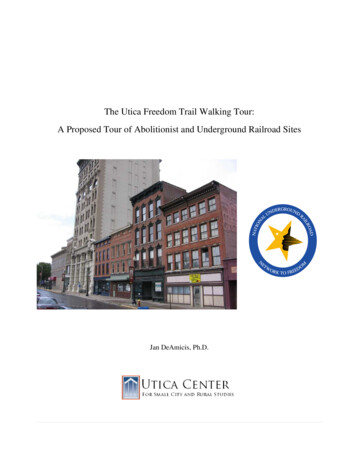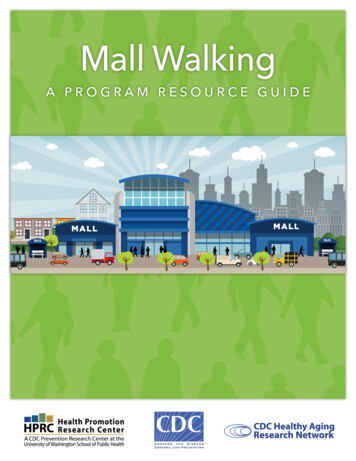
Transcription
The Utica Freedom Trail Walking Tour:A Proposed Tour of Abolitionist and Underground Railroad SitesJan DeAmicis, Ph.D.
The 1830s was the beginning of a particularly important period of the Underground Railroad inOneida County, New York. A dedicated abolitionist (Beriah Green) arrived to lead the nation’s first fullyintegrated college (The Oneida Institute of Science and Industry in 1833); the County’s first anti-slaverysocieties began (1832); the New York State Antislavery Society was formed and then attacked by a mob,(1835); two freedom seekers were violently rescued from slave-catchers (1836); the County’s firstAbolitionist newspaper began publishing (The Friend of Man, 1833), thousands of names were signedonto anti-slavery petitions to the US Congress from all over the County, and the annual meetings of theNew York State Anti-Slavery Society were held here (1837-1840). During the 1830s the County’s firstUnderground Railroad “stations” began to rescue escaping slaves. This Walking Tour will acquaintresidents and visitors alike with many of the sites associated with these historic events.The Abolition Movement demanded the immediate emancipation of all slavery in America. Manywhites thought it was extremist and even traitorous; many others were indifferent. But by the 1830s theAbolition Movement had exploded from one end of the state to the other, and Oneida County was in themiddle of it all. The Underground Railroad emerged from the Abolition Movement. “Stationmasters”would shelter escaping slaves and provide safe passage to other “stations.” However, slave-catcherssearched the region for runaways, and many whites would gladly collect a reward for betraying arunaway. Federal law strictly prohibited anybody from assisting fugitives, so the Underground Railroadusually operated in secrecy.Oneida CountyThe Revolutionary War left the Mohawk Valley virtually depopulated of Europeans, but after theWar, with the power of the Iroquois eliminated, millions of acres of land became available tothousands of land-hungry New Englanders.By 1830 about 72,000 people lived in Oneida County, more than double the 1810 population of34,000 and continuing the population surge that had characterized the County since the end of theRevolution. Attracted by plentiful land, and accessible by the Mohawk River, the Erie Canal, and amodern road system, Oneida offered many attractions to settlers from New England. Large tracts ofland were awarded to veterans of the Revolutionary War. General Floyd and Baron Von Steubeneventually settled on their Oneida County estates. Scattered across the county’s 18 towns were dozensof villages and 2 emerging cities, Utica and Rome.In 1830, about half of the County’s 462 blacks lived in Utica and Rome. These were free peopleof color, since slavery had been abolished by now in New York State. Black Oneidans would playsignificant roles in the Underground Railroad.In 1830 subsistence farming dominated the County’s economy, but the Erie Canal madeagriculture increasingly commercial: wheat and sheep at first, and later dairy products, hops, beans,and potatoes. Scattered across the County’s many rivers and streams were dozens, perhaps hundreds,of water-powered industries such as gristmills, textile factories, tanneries, sawmills, and bleacheries.In another decade or so, steam-powered factories would dominate the regional economy, but in 1830there were no steam engines anywhere around.1 Pa g e
Oneida County’s rapid growth and economic development brought new ideas and philosophies. Inthe 1820s the Mohawk Valley earned the title of The Burnt Over District because of the feverishChristian revivalism that swept the region. Beginning in 1830, powerful anti-slavery sentimentsemerged as well. The region became a stronghold of the Abolition Movement. There were 17 townsocieties by 1835, including Hamilton College, Oneida Castle, Sherburne, Vienna, Sherburne Ladies,Utica Juvenile Male and Juvenile Female. There were 5 anti-slavery societies in Utica. Many wereready to join the Underground Railroad.UticaBy 1830 Utica was the undisputed population and economic center of the county. It had about 9,000people; 1 out of every 8 people in the County lived here. By the time it received its city charter in 1832,it was alive with commercial activity: more than 100 specialty shops, including banks, taverns,blacksmiths, inns, stable, provisions (especially for westward-bound travelers on the Eric Canal),insurance companies, and law offices. Most white workers were craftsmen (46%) and merchants (17%).About 85% of black Uticans were unskilled laborers, such as hotel porters and day laborers. Most blackslived on post Street.New York’s Genesee Road began its trek west from its starting point where the highway met MainStreet in Utica. With John Street, Genesee and Main Streets formed Bagg’s Square, named for theenterprising Moses Bagg. Bagg had built astable and a hotel here, as well as the new brickprofessional office buildings (built in 1833 andnow on the National Historic Register) that linedGenesee Street, where judges, lawyers, andmerchants ran their businesses. The Erie Canalran just a few blocks south of Bagg’s Square,and as a result a steady stream of travelersstimulated such trades as wagon building, wheelrepair, and general provisioning. Bagg’s Squareis now a National Historic District. This is wherewe begin our walking tour of the UndergroundRailroad in Utica.The events of the Utica Rescue at Judge Hayden’s Office took place in Utica’s nationally recognizedGateway Historic District, Bagg’s Square West. These buildings are the oldest contiguous structures inUtica. Recently several new businesses have taken root near the Hayden Building: The Utica CoffeeRoasting Company, Master Pizza, and The Tailor and Cook Restaurant.2 Pa g e
1. 96-98 Genesee Street: The Utica Rescue at Judge Hayden’s OfficeOn December 29, 1836, Oneida County constables brought two Virginia fugitive slaves, HarryBird and George, before Oneida County Superior Court Judge Chester Hayden, at his private lawoffice located in this building. Hayden was about to turn the fugitives over to two slave-catcherswhen Spencer Kellogg, whose dry goods store was a few doors down the street, intervened. Kelloggdemanded a trial for the two men. Nearby Abolitionist lawyer Alvan Stewart soon joined them andoffered to defend the men. Hayden put the fugitives and slave-catchers in a back room until he couldreturn from his duties at the County Courthouse. While he was away, a crowd of black residentsbroke into the office building, overpowered the slave-catchers, and rescued the fugitives.1. Hayden Building2. Kellogg’s Store3. Stewart’s LawOffice9. 2nd PresbyterianChurch5. 1836 Site of OneidaCounty Courthouse4. Post Street7. Blaikie’sDrugstore6. MechanicsHall8. James DeLong’sHome3 Pa g e
This is The Hayden Building: 96-98 Genesee Street, thebuilding where the Utica Rescue at Judge Hayden’s Officetook place. The National Park Service now officiallyrecognizes this site as a national Underground Railroad site.This allows us to display the NPS logo4 Pa g e
2. 110 Genesee Street: Spencer Kellogg’s Dry Goods StoreThis was the site of Spencer Kellogg’s dry goods store, just few doors southfrom the Hayden Building. The site of his store is now occupied by the Genesee TowerApartments.This overall structure of 6 contiguous brick buildings is now on the National Registry of HistoricBuildings. It is the oldest row of contiguous buildings in the city of Utica.Genesee TowerApartmentsA charter member of the New York State Antis-Slavery Society, SpencerKellogg was a dedicated Abolitionist. When Judge Hayden was ready toturn the fugitives over to the Virginia slave-catchers, Kellogg insisted thatHarry Bird and George were free men of color and deserved a legalhearing.5 Pa g e
Spencer Kellogg was a merchant and prominent citizen. He served on theUtica school board, and in 1840 was elected the city’s mayor. He wasTreasurer of the New York State Anti-Slavery Society when it was firstorganized (and disrupted), and for several years thereafter. He was alsoPresident of its Executive Committee. Some of the members of the UticaMob even threatened to torch his home. Kellogg observed Harry Bird andGeorge from outside his store at 110 Genesee, a few doors away fromHayden’s office. The Genesee Towers Apartments now occupies the site.3. 120 Genesee Street: Alvan Stewart’s Law Office.6 Pa g e
Alvan Stewart’s law office was located in the building that is nowGreat Rentals. Stewart played a central role in the Utica Rescue atJudge Hayden’s Office. Spencer Kellogg summoned Stewart to JudgeHayden’s law office to represent the 2 captured freedom seekers.Stewart argued that the two captives were in fact free men of color,and he was prepared to defend their interests. Judge Hayden decidedto resolve the issue later after work at the Oneida County Courthouse.That day-long delay permitted rescuers to break into Hayden’sbuilding, and rescue the runaways.Alvan Stewart was a well-known Abolitionist lawyer. His office waslocated in what is now the Great Rentals building, 30 yards southfrom the Hayden Building. Its corner-stone inscription, “1833,”helped identify the Hayden Building. Stewart was born to farmparents in moderate circumstances in 1790 in Washington County,New York. He practiced law in Cherry Valley, New York, for 16 years, where he was elected as mayor.In September 1835 he issued a call for the formation of a state anti-slavery society, which led to theformation of the New York Anti-Slavery Society. He was also a gubernatorial candidate of the LibertyParty, which advocated for the abolition of slavery.4. Post StreetPost Street Circa 1840Post Street TodayIn 1836, most of Utica’s 240 black residents lived on Post Street, just a few blocks away from theHayden. Post Street then was home to boarding houses and taverns. Since slavery had ended in NewYork only 9 years earlier, its residents understood what bondage meant. Indeed, some had probablybeen enslaved themselves. This is where Harry Bird and George were probably living when theywere arrested. Word of their arrest spread quickly; newspaper accounts say that a crowd of black menlingered all day around Hayden’s building. At nightfall they stormed into the room where the7 Pa g e
fugitives and slave-catchers waited, overwhelmed the Virginia captors, and released the freedomseekers. By freeing the fugitives, they broke federal law. None, however, were ever punished.Post Street’s African Americans were active in the Underground Railroad. For instance, in 1846William Johnson, a black barber living on Post Street, worked with white abolitionist William Blaikieto spirit 2 fugitives out of Utica. In 1855 a local newspaper noted that a family of freedom seekers hadpassed through Post Street on their way to Canada. Johnson was one of many black Oneidans whowere involved in the Negro Convention Movement of the 1840s.8 Pa g e
5. Oneida County CourthousePost StreetHayden BuildingChancellor Square Park Today9 Pa g e
10. Devereaux Block9. 2nd PresbyterianChurch11. Gerrit re8.James DeLong’sHome6. Mechanics Hall, Liberty StreetMechanics Hall was built in 1837 and is oneof Utica’s oldest structures. Abolitionistssometimes lectured here, some of whomwere former slaves. The Civil War draftfor the City of Utica was held atMechanics Hall on August 28, 1863. InDecember 1924, fire completelydestroyed the upper part of the buildingwith an estimated damage of upwards of 100,000. It was thereafter repaired.Civil War Draft at Mechanic’s Hall, 186310 P a g e
Mechanic’s Hall Today7. 2203 Genesee Street, William Blaikie’s ApothecaryWilliam Blaikie owned an Apothecary, later Watford’s Drug Company, on Genesee Street. Threats weremade against the Blaikie family and at times they were compelled to leave their residence on this account.Blaikie frequently sheltered runaway slaves here and at his home in the outskirts of the city.11 P a g e
8. 101 John Street: Site of James B. DeLong’s HomeJames DeLong was a delegate to the New York State Anti-Slavery Convention (interrupted by a mob Ledby Chester Hayden) in Utica in 1835. He became an active conductor in the Underground Railroad. Hishome on upper John Street was one of the stations and he often secreted runaway slaves in the BleeckerStreet Methodist Church, of which he was a founder. His home was located on the triangle of land borderedby John, Blandina Park Avenue, where the former home of the Oneida County Historical Society once waslocated. DeLong owned a leather factory on Water Street.Site of DeLong’s home today9. Second Presbyterian ChurchOn October 21, 1835, 600 delegates met in the Bleecker Street Presbyterian Church to organize the NewYork State Anti-Slavery Society. A large crowd of anti-abolitionist protesters disrupted the proceedings.Among the prominent protesters was Judge Chester Hayden who read their demands; he figured prominentlyin the Utica Rescue. The meeting adjourned without conducting its business. However, Gerrit Smith invitedthe delegates to re-assemble at his Peterboro estate in Madison County, estate, about 30 miles away. Therethe New York State Anti-Slavery Society was founded, with many Oneidans in the lead.12 P a g e
Site of 2nd Presbyterian Church today10. Devereaux Block: Wesley Bailey PublisherWesley Bailey was the publisher and proprietor of the abolitionist Liberty Press. He harboredJohn Thomas and one other freedom seeker in 1844. Bailey directed them to Jesse Thompson, onParis Hill, where a fugitive community prospered.11. 600 Broad Street: Gerrit Smith BirthplaceGerrit Smith was an important abolitionist. He was a delegate to Utica’s 1835 New York State AntiSlavery Convention. He donated enormous sums of money to the Abolitionist cause after witnessingthe “outrageous” behavior of the Anti-Abolitionist rioters. The disrupted convention re-convened atSmith’s Peterboro estate in Nearby Madison County. Peterboro became a well-known UndergroundRailroad Station as well. It is now the home of the National Abolitionist Hall of Fame.Gerrit Smith13 P a g e
About the AuthorJan DeAmicis is an. historical sociologist with interests in the experience of race and ethnicity. Hisrecent research is reflected in the Underground Railroad project in which he utilizes historical andarchaeological data to analyze this important institution in the history of upstate New York.14 P a g e
This Walking Tour will acquaint . War, with the power of the Iroquois eliminated, millions of acres of land became available to . broke into the office building, overpowered the slave-catchers, and rescued the fugitives.










